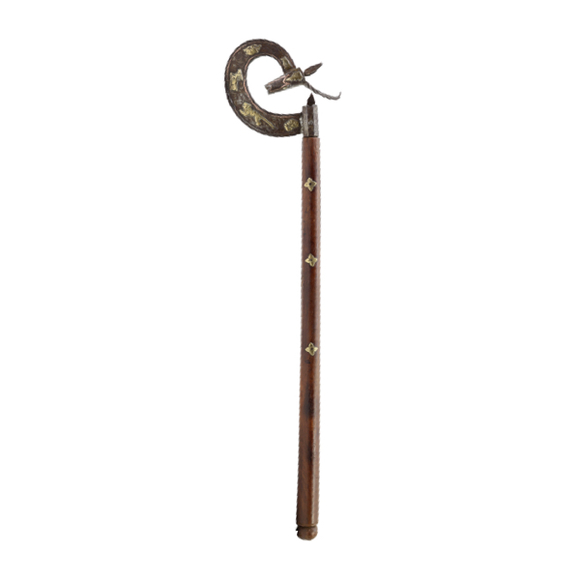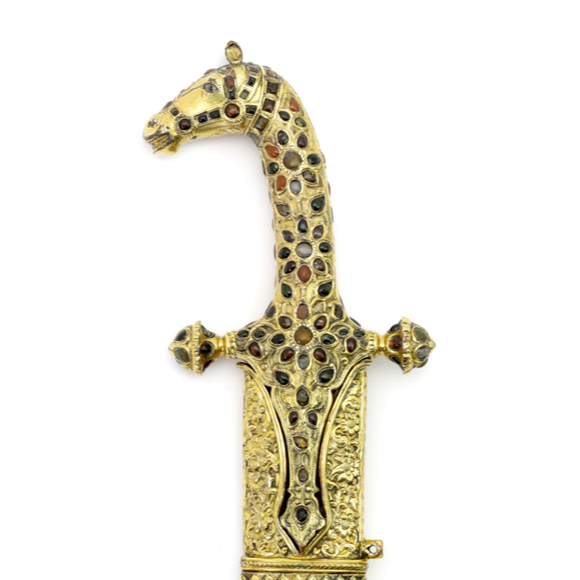Update:
I was contacted by the museum on February 12th, who notified me they had removed the cabinet.
They will set up an entirely new Asia Room in spring, and they invited me for a tour. Looking forward to seeing the changes and I'll report on them in a new blog post.
Introduction
Museums as institutions are meant to inform. The government and the general audience typically hold them in very high regard. In a time of changing views on collections and collecting, sometimes leading to the repatriation of items, museum staff are the first and often only experts to be consulted.
Sadly, due to budget cuts and increased focus on commercialism, the expertise held by museums is generally in decline. Curators do less and less actual curatorial work, and often work primarily as project managers. It is starting to show.
I recently stopped by the Wereldmuseum (National Museum of Ethnology) in Leiden to see if anything new was on display. My eye fell on a glass cabinet labeled "Mogol" (Mughal) that contained a number of items, each and every one of them is misattributed.
Let's take a closer look:
"Mogol" items at the Leiden Wereldmuseum
The display is titled Mogol, Dutch for Mughal, a North Indian dynasty with Timurid roots that lasted from 1526 to 1857.
The glass vitrine comes with a sign that gives the visitor a little introduction to the culture:

A nice introduction to the culture. Power and wealth, a scientific center. Hopes are high!
The objects selected to illustrate however are as follows:

All these items postdate the Mughal dynasty. Most are British Raj period tourist curios, not meant for the local market but for foreign tourists and travelers. The common denominator is crude workmanship, and decoration that is often little more than filling space with quasi-traditional motifs.
Let's treat some of them individually.

Left: RV-759-111
Museum Description: Ceremonial sword, South India, 19th century.
Provenance from database: Purchase, 1889.
What it is: Tourist curio item of Northern India, late 19th century.
Its blade is vaguely in the form of a Nepalese kora.
Right: RV-759-108
Museum description: Axe. South India, 19th century.
Provenance from database: Purchase, 1889.
What it is: Tourist curio item of Northern India, late 19th century.
Both of these exhibit the typical workmanship of late 19th-century pieces made entirely for the curio trade. The overkill of decoration is superficial and sloppy up close. The weapons are not well-shaped, and the surface finish is coarse.
The Mughals were a Muslim conquest elite, and the Rajputs were local Hindu warrior-rulers with some similarities in status to the knightly class of Europe or the Samurai of Japan. Neither group would carry items like this.

Left to right:
Museum description: Indian sword, before 1911.
Provenance from database: Purchase, 1911.
What it is: Tourist curio item of Northern India, late 19th century. Very crude workmanship.
Museum description: Indian sword, before 1914.
Provenance from database: Gift, 1914.
What it is: Tourist curio item of Northern India, late 19th century. The work on the blade is particularly bad, indicating it was never intended to be anything more than a wall hanger.
Museum description: Indian sword, 1700-1900.
Provenance from database: Purchase, 1893.
What it is: Tourist curio item of Northern India, late 19th century. Extremely crude hilt, with very weak connection between knuckle guard and grip. Wallhanger.
Museum description: Indian sword, 1800-1900.
Provenance from database: Gift, 1965.
What it is: This is the best piece of the group, but still postdates the Mughal period and exhibits superficial, "space filler" type decoration that is normally associated with the British Raj period. It, too, is most likely a tourist curio and not made for a proud Rajput. Workmanship on gold overlaid hilts made "for the culture" remained of a much higher standard to well into the 20th century.

Museum description: Indian katar, 1700-1900.
Provenance from database: Gift, 1882.
What it is: Tourist curio item. Possibly not even Indian, but trying to be. This katar is a joke. It was obviously made by someone who was not familiar with the weapon. Nothing about the form or construction is traditional. The handlebars are too far apart for a decent grip. The superficial silverwork is of a type done from Syria to India and gives no hint as to the place of manufacture.

Museum description: Shield, Iran, Mughal or Rajput, before 1882.
Provenance from database: Gift, 1882.
What it is: These shield were made among others in Isfahan, Persia (Iran). While some of them indeed made it to India, it would be wrong to assert they are Mughal or Rajput. The workmanship on these varied from excellent to basic, this being an example of the lesser workmanship. The associated helmet is also from Persia. It is missing part of its top spike and one of the plume holders.

Museum Description: Saber, India, before 1891.
Provenance from database: Purchase, 1891.
What it is: The most peculiar of the misattributions and, although quite modest in execution, probably the best item in the display for being an honest weapon that was made "for the culture".
But this culture is not Mughal, not even India. This is a peudeueng from Aceh, North Sumatra. How they got this one wrong is beyond me, not just because of our colonial history with Indonesia but also because they did get it right in their collection database.
It's a sign of regression because these same sabers were more accurately described over a century ago by their former curator H.W Fischer in Catalogus van 's Rijks Ethnografisch Museum Deel IV, Atjèh, Gajō- en Alaslanden. Sumatra I. Brill, Leiden, 1912. Page 171. To illustrate the curatorial decline in the museum since Fischer's time, I quote former director of the museum, H.H. Juynboll:
"Niemand kan misschien beter dan ik getuigen van zijn buitengewonen ijver en werkkracht en zijne streng methodische wijze van werken. Voordat hij begon met een deel van den wetenschappelijken Catalogus, verzamelde hij eerst, niet alleen uit de bibliotheek van het Museum, maar ook uit de Leidsche Universiteitsbibliotheek en andere bibliotheken de geheele literatuur over een bepaalde landstreek en teekende bij elk der twaalf groepen, waarin Mr. Serrurier alle ethnographische voorwerpen verdeeld heeft, steeds aan, wat er in de literatuur over voorkomt. Zijne zeldzame belezenheid maakte, dat geen bron hem ontging."
Translated:
"Perhaps no one can testify better than I to his extraordinary zeal and energy and his strict methodical way of working. Before he started with part of the scientific Catalog, he first collected all the literature on a particular region, not only from the Museum library, but also from the Leiden University Library and other libraries, and made a drawing of each of the twelve groups in which Mr. Serrurier has divided all ethnographic objects, always according to what appears in the literature about them. His rarely encountered well-readedness meant that no source escaped him."
From: H.H. Juynboll; Levensbericht van H.W. Fischer
Jaarboek van de Maatschappij der Nederlandse Letterkunde, 1918
Also see my glossary article: Peudeueng
Summary
Apart from the peudeueng, the above items are of a type, quality, and condition that would make me advise any serious collector to steer away from them. Basic workmanship can be forgiven if the item is an honest production, made for the culture. But in this case, the items were not made for a local market at all.
The Mughal rulers and the Rajput noble families came from proud warrior backgrounds. Their weapons, even the simple ones, were much better than what is presented here.
What strikes me from the collection database entries is that with most entries the only work cited is E. Jaiwant Paul; Arms and Armour, traditional weapons of India. This is not considered a very reliable or in-depth work. Any serious survey into the subject should involve getting familiar with the 19th-century writings of Lord Egerton and Thomas Holbein Hendley, reports from the Indian exhibitions. In more recent times, Rawson, Elgood, Alexander, and several others have added significantly to our understanding.
Some good Mughal period weapons
If you made it here, I must apologize for dragging you through so many sub-standard items. Here are some items I am working with that better represent the culture.
"It is most common to use only gold or gold leaf for the prominent portions of a work, the sides and back parts being often done in silver, but both metals are frequently employed together with good effect, the silver threading in and out amongst the gold. Such a combination is styled Ganga - Jamni, from its supposed resemblance to the mingling of the dark waters of the Jamna with the muddy stream of the Ganges at the Triveni, or their point of union with the mystic Sarasvati below the fort at Allahabad. Although the Punjab is so prominent for damascening, the most artistic work is done in Rajputana, or wherever the Rajput lives."
-Thomas Holbein Hendley; Damascening on steel or iron as practiced in India.
W. Griggs & Sons, Ltd. London 1892. Page 9.

Horsehead Shamshir from Kutch, Gujarat, north India. Circa 1800.
Current Inventory

A fine Rajput talwar. Princely state of Ratlam, Madhya Pradesh, India.
Blade dated 1744, hilt dated 1759.
Sold in 2020


Rajput katar with wootz blade and chiseled iron hilt with rubies and diamonds. 19th century.
Sold in 2023



Talwar of Mohta Bakhtawar Singh, chief minister of Bikaner. Dated 1756.
Sold in 2021
Conclusion
The Ethnographic museum in Leiden has on exhibit a Mughal cabinet containing not a single item that can be confidently attributed to the Mughal dynasty, or having anything to do with the Mughals or Rajputs that the caption describes. Almost all items are post-Mughal, British Raj period items made for the curio market. Others are not even Indian, the armor is Persian and one saber is an Acehnese peudeueng.






